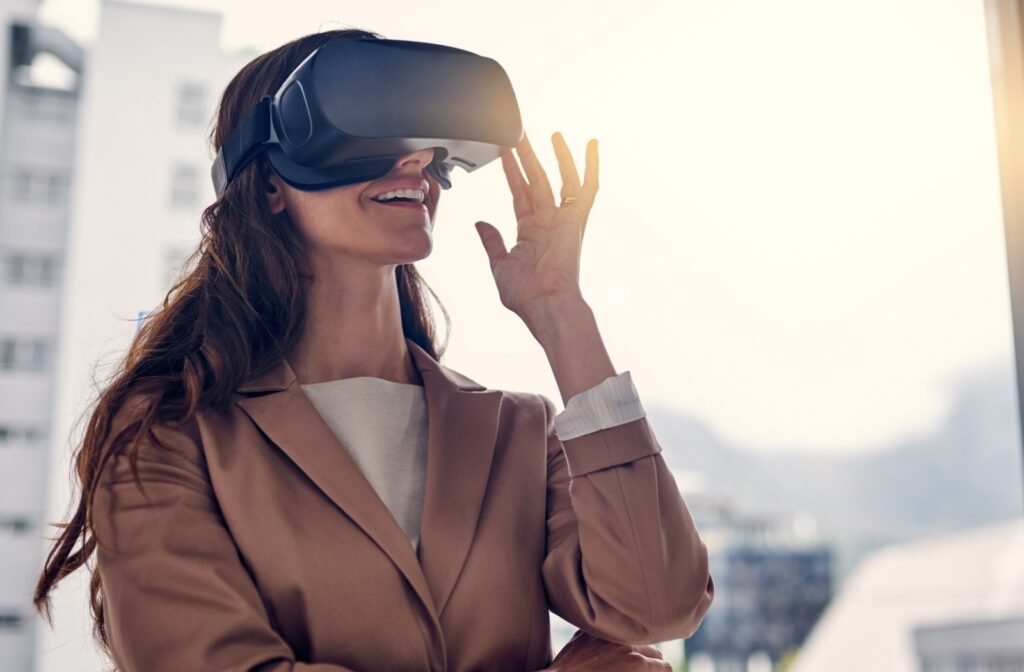Virtual reality (VR) has grown from a niche technology into a mainstream tool for gaming, education, workplace training, and even healthcare. With VR headsets becoming more accessible, many people spend extended periods immersed in virtual environments. But with this increased use comes an important question: Is virtual reality bad for your eyes?
While VR provides an engaging and interactive experience, prolonged use can contribute to eye strain, discomfort, and other vision-related concerns. Understanding how VR affects eye health, recognizing potential risks, and learning how to minimize strain can help users enjoy the technology safely.
What Is VR?
Virtual reality (VR) is a technology that creates an immersive digital experience, allowing users to interact with computer-generated environments in a lifelike way. VR headsets use high-resolution screens, motion tracking, and stereoscopic imagery to simulate real-world depth and movement, making users feel as if they are inside a different reality.
VR is widely used in gaming, education, training simulations, and even healthcare. It allows users to explore virtual landscapes, practice real-world skills, and engage with digital environments in ways that traditional screens can’t replicate. However, because VR requires close-up screen exposure and intense visual focus, it can place unique demands on the eyes, raising questions about its impact on eye health.
How Does Virtual Reality Affect the Eyes?
VR headsets create an immersive experience by placing screens close to the eyes and simulating depth perception using stereoscopic images. Unlike traditional screens, VR displays require the eyes to focus and converge in ways that differ from real-world vision, which can sometimes lead to visual fatigue and discomfort.
Common Vision Issues Linked to VR Use
- Digital eye strain – Extended VR sessions can cause dry eyes, headaches, blurred vision, and difficulty refocusing
- Vergence-accommodation conflict – VR causes the brain receive conflicting signals about depth, leading to discomfort, fatigue, and dizziness
- Motion sickness – Disorientation from VR movement can result in nausea and imbalance
- Temporary changes in depth perception – Some people have difficulty adjusting to real-world vision after extended VR use
Most of these effects are temporary, but frequent exposure without proper precautions can lead to persistent discomfort or worsening vision strain over time.
Does VR Cause Long-Term Eye Damage?
There is currently no conclusive evidence that VR causes permanent eye damage, but improper use and excessive screen time can contribute to short-term visual discomfort and strain.
What Research Says About VR and Eye Health
- VR exposure doesn’t seem to cause structural damage to the eyes, but it can overwork the visual system, leading to fatigue
- Studies suggest that excessive near-screen exposure may increase the risk of myopia (nearsightedness), particularly in children
- Extended VR sessions can result in temporary visual disturbances, such as difficulty refocusing and increased light sensitivity
While research is ongoing, moderation and proper usage techniques can significantly reduce the risk of VR-related eye discomfort.
Who Is Most Affected by VR-Related Eye Strain?
Some people may be more prone to VR-related vision issues due to pre-existing conditions or visual sensitivities.
Groups More Likely to Experience Eye Strain from VR
- Children and teenagers – Developing vision systems may be more vulnerable to excessive screen exposure
- People with uncorrected vision problems – Conditions such as astigmatism, myopia, and presbyopia may make it harder to focus in VR
- Individuals prone to motion sickness – Some users may feel dizziness, nausea, or vertigo from fast movements in virtual environments
- People with dry eye syndrome – Staring at VR screens reduces blinking, which can worsen dryness and irritation
- People who use VR for extended periods – Those who regularly engage in long gaming sessions, workplace training, or simulations are at higher risk of visual fatigue
If discomfort persists after VR use, consulting an optometrist can help determine if adjustments are needed for safer and more comfortable VR experiences.
Tips to Reduce Eye Strain While Using VR
While VR can cause strain, adopting good habits can help protect vision and prevent discomfort.
Best Practices for Eye Comfort in VR
- Follow the 20-20-20 rule – Every 20 minutes, look at an object 20 feet away for at least 20 seconds to rest your eyes
- Adjust headset settings – Ensure the interpupillary distance (IPD) is set correctly for clearer, strain-free vision
- Blink more often – Reduce dry eyes by consciously blinking more frequently during VR sessions
- Limit session length – Take breaks between sessions rather than using VR for long periods
- Use proper lighting – Avoid using VR in complete darkness, as high contrast can increase strain
- Wear corrective lenses if needed – Some VR headsets accommodate prescription lens inserts for clearer viewing
By following these simple adjustments, VR users can reduce eye fatigue and improve overall comfort.
Can VR Be Beneficial for Eye Health?
Despite concerns about eye strain, VR technology is also being used in vision therapy and rehabilitation to help treat certain eye conditions.
Potential Vision Benefits of VR
- Amblyopia (lazy eye) treatment – VR exercises help train the brain to use both eyes more effectively
- Depth perception training – Certain VR programs improve stereopsis (3D vision perception)
- Eye-tracking exercises – VR-assisted therapy strengthens eye coordination, tracking, and focus
While not all VR applications improve vision, its role in eye health continues to evolve, offering new treatment possibilities for visual impairments.
Should You Stop Using VR?
There is no need to completely avoid VR, but responsible use is essential to protect long-term eye health. Most concerns arise from overuse or incorrect headset settings, which can be mitigated with proper usage habits.
When to Take Extra Precaution
- If eye strain persists, even after taking breaks
- If frequent dizziness or headaches occur post-VR use
- If pre-existing vision conditions worsen over time
If symptoms do not improve, an eye exam with an optometrist can help determine whether VR use should be adjusted or limited.
Prioritizing Eye Health for Everyone at York Mills
Virtual reality is an exciting and rapidly growing technology with numerous applications. While it doesn’t appear to cause permanent eye damage, improper use can lead to temporary vision discomfort and strain.
At York Mills Eye Care, we prioritize comprehensive eye health assessments and provide guidance on how to protect vision while using digital devices and VR. If you experience discomfort while using VR or have concerns about your eye health, schedule an eye exam with us today to ensure your vision remains clear and comfortable.




